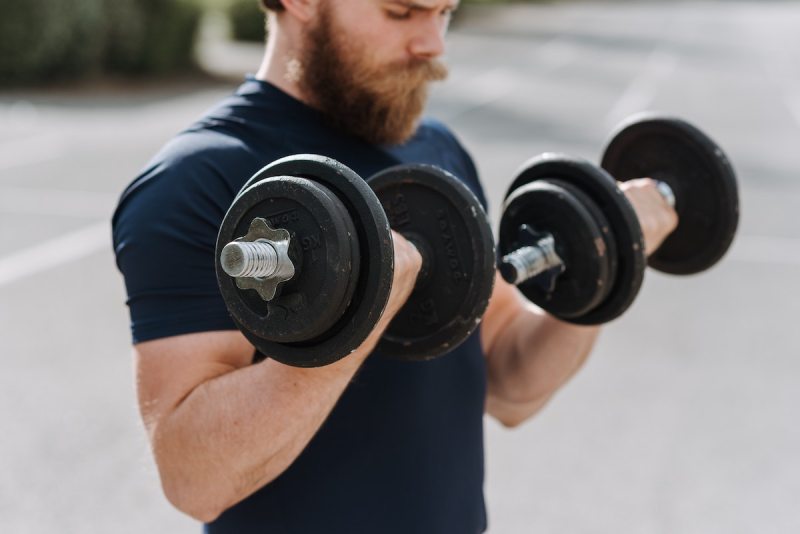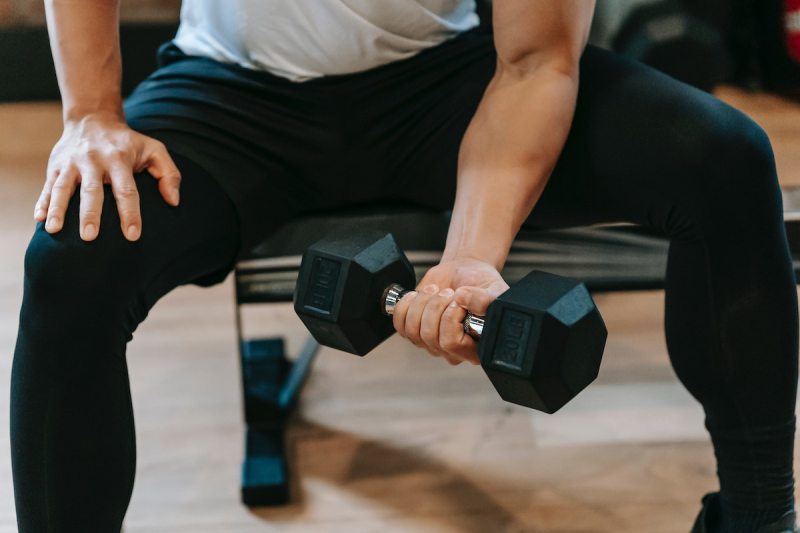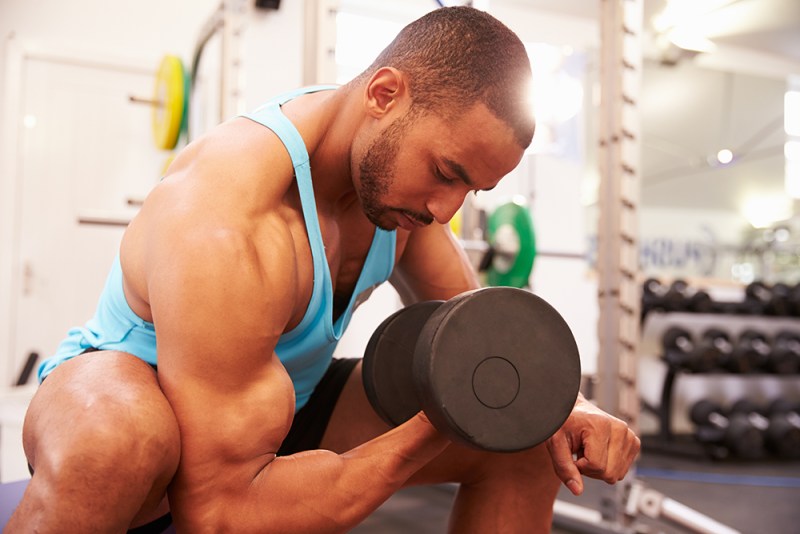
If you want to build bigger and stronger biceps, you don’t need a fancy gym or expensive equipment. All you need is a pair of dumbbells and some motivation. Dumbbells are versatile, convenient, and effective tools for working your arms and other muscle groups.
This article will show you five dumbbell exercises that will challenge your biceps and help you achieve your fitness goals. Whether you are a beginner or an advanced lifter or looking to gain muscle or lose weight, you can adjust the weight, reps, and sets according to your level and preference.
Ready to get started? Grab your dumbbells, and let’s go!

How do you get bigger biceps with just dumbbells?
The biceps are composed of two main muscles: the biceps brachii and the brachialis. The biceps brachii is the larger muscle and splits into two “heads” that attach to different parts of your shoulder but act as one muscle. The brachialis is a smaller muscle that lies underneath the biceps brachii.
To get bigger biceps with just dumbbells, you need to work both of these muscles with different angles and grips. You also need to apply the principles of progressive overload, which means increasing the weight, reps, or sets over time to stimulate muscle growth.
Also, make sure to eat enough protein and calories to support your recovery and muscle building. Finally, rest your biceps between workouts to allow them to heal and grow.
You might want to expand from using dumbbells to other affordable tools like resistance bands for best results.

5 dumbbell exercises for stronger biceps
Bicep curls
Bicep curls are the classic and most popular bicep exercise. They work both the long and short heads of the biceps brachii and the brachialis for an overall workout.
Instructions:
- Stand with your feet shoulder-width apart and hold a dumbbell in each hand, with your palms facing up and your arms extended by your sides.
- Keeping your elbows close to your body and your upper arms stationary, curl the dumbbells towards your shoulders, squeezing your biceps at the top.
- Slowly lower the dumbbells back to the starting position, keeping tension on your biceps throughout the movement.
- Repeat for the desired number of reps and sets.
Hammer curls
Hammer curls are similar to bicep curls but with a different grip. They work more on the brachialis and the brachioradialis, which is a forearm muscle that helps flex the elbow.
Instructions:
- Stand with your feet shoulder-width apart and hold a dumbbell in each hand, with your palms facing each other and your arms extended by your sides.
- Keeping your elbows close to your body and your upper arms stationary, curl the dumbbells up towards your shoulders, keeping your palms facing each other throughout the movement.
- Slowly lower the dumbbells back to the starting position, keeping tension on your biceps and forearms throughout the movement.
- Repeat for the desired number of reps and sets.
Concentration curls
Concentration curls are an isolation exercise that focuses on the peak of the biceps. They work mainly on the long head of the biceps brachii, which is responsible for the biceps’ height and shape.
Instructions:
- Sit on a bench or a chair and hold a dumbbell in one hand, with your palm facing up and your arm extended.
- Place your elbow on the inside of your thigh, near your knee, and rest your other hand on your leg for support.
- Curl the dumbbell up towards your shoulder, keeping your elbow and upper arm still and your wrist straight.
- Pause and squeeze your biceps at the top, then slowly lower the dumbbell back to the starting position, keeping tension on your biceps throughout the movement.
- Repeat for the desired number of reps, then switch sides and repeat with the other arm.
Preacher curls
Preacher curls are another isolation exercise that targets the biceps. They work mainly on the short head of the biceps brachii, which is responsible for the biceps’ width and thickness. To perform preacher curls, you will need a preacher bench or a similar surface that can support your upper arms.
Instructions:
- Adjust the height of the preacher bench so that your armpits are comfortably resting on the top of the pad.
- Hold a dumbbell in each hand, with your palms facing up and your arms extended over the pad.
- Keeping your upper arms and chest pressed against the pad, curl the dumbbells up towards your shoulders, squeezing your biceps at the top.
- Slowly lower the dumbbells back to the starting position, keeping tension on your biceps throughout the movement.
- Repeat for the desired number of reps and sets.
Decline bicep curls
Decline bicep curls are a variation of bicep curls that change the angle of the exercise. They work more on the long head of the biceps brachii, as well as the brachialis. To perform decline bicep curls, you will need a bench that can be set to a decline position.
Instructions:
- Set the bench to a 45-degree decline and lie down on it with your head lower than your feet and your chest facing up.
- Hold a dumbbell in each hand, with your palms facing up and your arms extended by your sides, perpendicular to the floor.
- Keeping your elbows close to your body and your upper arms stationary, curl the dumbbells up towards your shoulders, squeezing your biceps at the top.
- Slowly lower the dumbbells back to the starting position, keeping tension on your biceps throughout the movement.
- Repeat for the desired number of reps and sets.

Do biceps grow better with weight or reps?
There is no single answer to this question. Different people might have different results, and you’ll probably be best off increasing both your weight and your reps over time. There are some other general guidelines that can help you optimize your bicep workouts for muscle growth, though, so let’s take a look.
Find a weight that is challenging enough to fatigue your biceps within a moderate rep range, usually between 8 and 15 reps per set. If you can do more than 15 reps with ease, the weight is too light, and you are not stimulating your biceps enough. If you can do less than eight reps with difficulty, the weight is too heavy, and you are not getting enough volume and time under tension for your biceps.
Second, you need to vary your rep ranges and weights periodically to avoid plateaus and keep your biceps guessing. For example, you can do a heavy day, where you use a weight that allows you to do 6 to 8 reps per set, and a light day, where you use a weight that allows you to do 12 to 15 reps per set.
As you gain strength and muscle, you will be able to use larger weights for the same number of reps. Progressively increasing both the weight and the number of reps will help you to continue to become stronger and avoid plateaus.

What is the best bicep workout for bigger biceps?
The best dumbbell workout is the one that works for you. There is no one-size-fits-all bicep workout for everyone. However, some general principles can help you design your own bicep workout that is effective, efficient, and enjoyable.
First, you need to decide how much to focus on your biceps. Some people dedicate a whole session to their biceps, while others like to combine them with other muscle groups. In general, you should aim for variety in your workouts and only train any particular area once every two or three days. The AHA recommends doing strength training at least two times a week, but that doesn’t have to be only biceps.
Second, choose the exercises, sets, and reps that you want to do for your biceps. As mentioned earlier, you should use a variety of exercises that target different parts of your biceps and vary your rep ranges and weights periodically. A good bicep workout should include at least 3 to 4 exercises and 9 to 12 sets total, with 8 to 15 reps per set.



